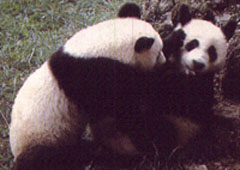Length:6 feet
Height: up to 5 feet
Weight: up to 330 pounds
Number of young: 1
Home: West Central China

The giant panda's natural surroundings are the cold and wet bamboo forest in west-central China. In summer it stays mainly on the high plateaus, moving to the valleys in the winter. Panda's were discovered in 1869. They began appearing in zoos outside China in the late 1930's, and have been very popular with the public ever since. They are very rare animals. There may be fewer than 1000 left. Farming and the increased development of forests continue to destroy their natural surroundings.

Despite its resemblance to a teddy bear, the giant panda is more closely related to racoons than to bears. The giant panda weighs more than 200 pounds and has very powerful teeth that it uses to chew the bamboo on which it feed. The female gives birth to a single cub in August or September. The baby is lovingly cared for by its mother. The young panda is very active and playful. On the rare occasion that a panda gives birth in a zoo, newspapers cover the story in great detail.

In the wild, the panda feeds on bamboo shoots, which it eats in great quantities: over 80 pounds a day. In zoo's it sometimes eats meat. When a panda eats, it sits down, freeing its forepaws, which it uses like claws. The paws have 6 fingers, including a special thumb that allows the animal to hold plant stems easily. To keep its stomach filled, the panda spends 16 out of every 24 hours eating!

The Duck's House
Geocities
| Member of the Internet Link Exchange | Free Home Pages at GeoCities |